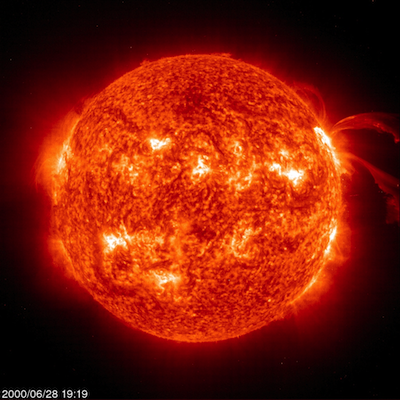
The Sun's sausage waves and super solar flares
BY KULVINDER SINGH CHADHA
ASTRONOMY NOW
Posted: 26 June 2014

Pulsing tubes of magnetic energy on the Sun and super-flares of enormous power were just some of the exciting solar subjects under discussion at the National Astronomy Meeting in Portsmouth this week.

Bright areas in this images of the Sun are active regions where magnetic flux is concentrated. Oscillating tubes of magnetic energy in these regions are helping to heat the corona. Image: SOHO (NASA/ESA).
The Sun's dynamical interface region, which is found between the photosphere (the Sun's 'surface') and the corona (the Sun's outer atmosphere), is an area rich in both activity and mystery. The region is dominated by complex magnetic fields and plasma ranging from hundreds of thousands to millions of degrees hot. From the top of the chromosphere (the lower 'atmosphere') upwards the temperature increases rapidly. The reason for this is unclear and is a continuing area of research. Pressure pulses oscillating in vertical magnetic flux tubes (so-called 'sausage waves', named because of their shapes) could be one process that transfers energy to the upper solar atmosphere.
The sausage waves are not dependent on the Sun's magnetic activity, says Dr Andrew Gascoyne of Sheffield University, who presented his work on these oscillations at the conference. "They are trapped waves that occur continuously over the solar cycle," he says.
Unlike the sausage waves, solar flares are directly related to magnetic activity and, during another talk, Professor Kazunari Shibata of Tokyo University put forward a terrifying scenario. Studies of data from the Kepler Space Telescope show Sun-like stars are prone to super flare events that release up to ten thousand trillion trillion joules (1028 joules, which is a thousand times more powerful than normal).

A solar flare saturates the camera on NASA's Solar Dynamic Observatory. Could a super-flare send civilisation back to the Stone Age? Image: NASA/SDO.
Previously it had not been though that stars like our Sun could undergo such violent events. If a super flare were to erupt from the Sun (which Shibata predicts should occur every 800-5,000 years) then astronauts and air travellers would receive a lethal dose of radiation, all artificial satellites would be destroyed and would global electricity transmission would cease. A solar super flare would send humanity back to the Stone Age.
On this frightening possibility, Gascoyne is open, but cautious. "We're in quite a strange period where the Sun's not as active as we’re expecting, so it's very unlikely. Activity on the Sun is also very complicated, so it is very difficult to predict such an event."
|



